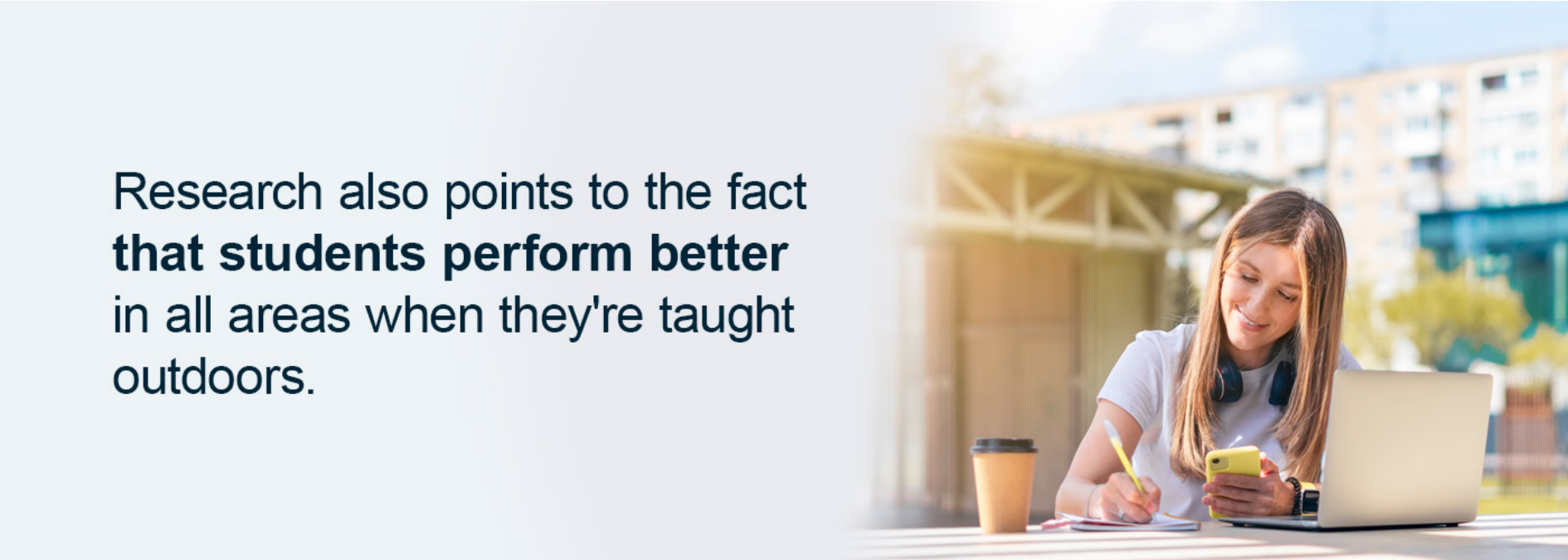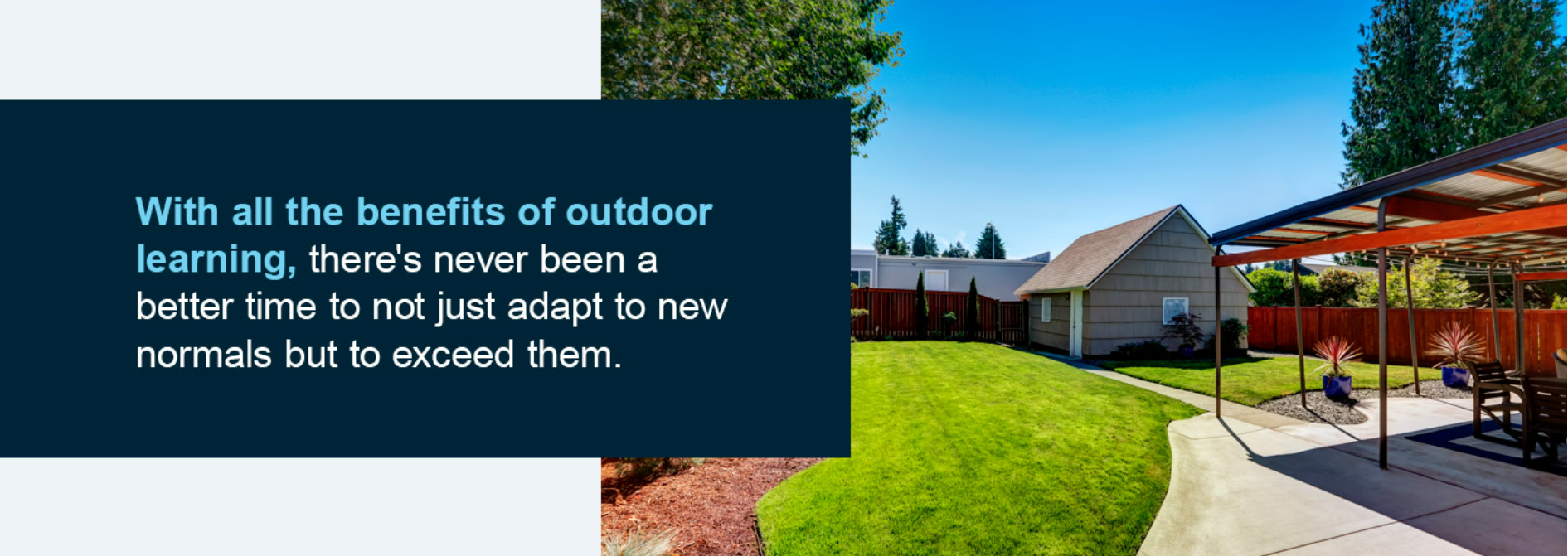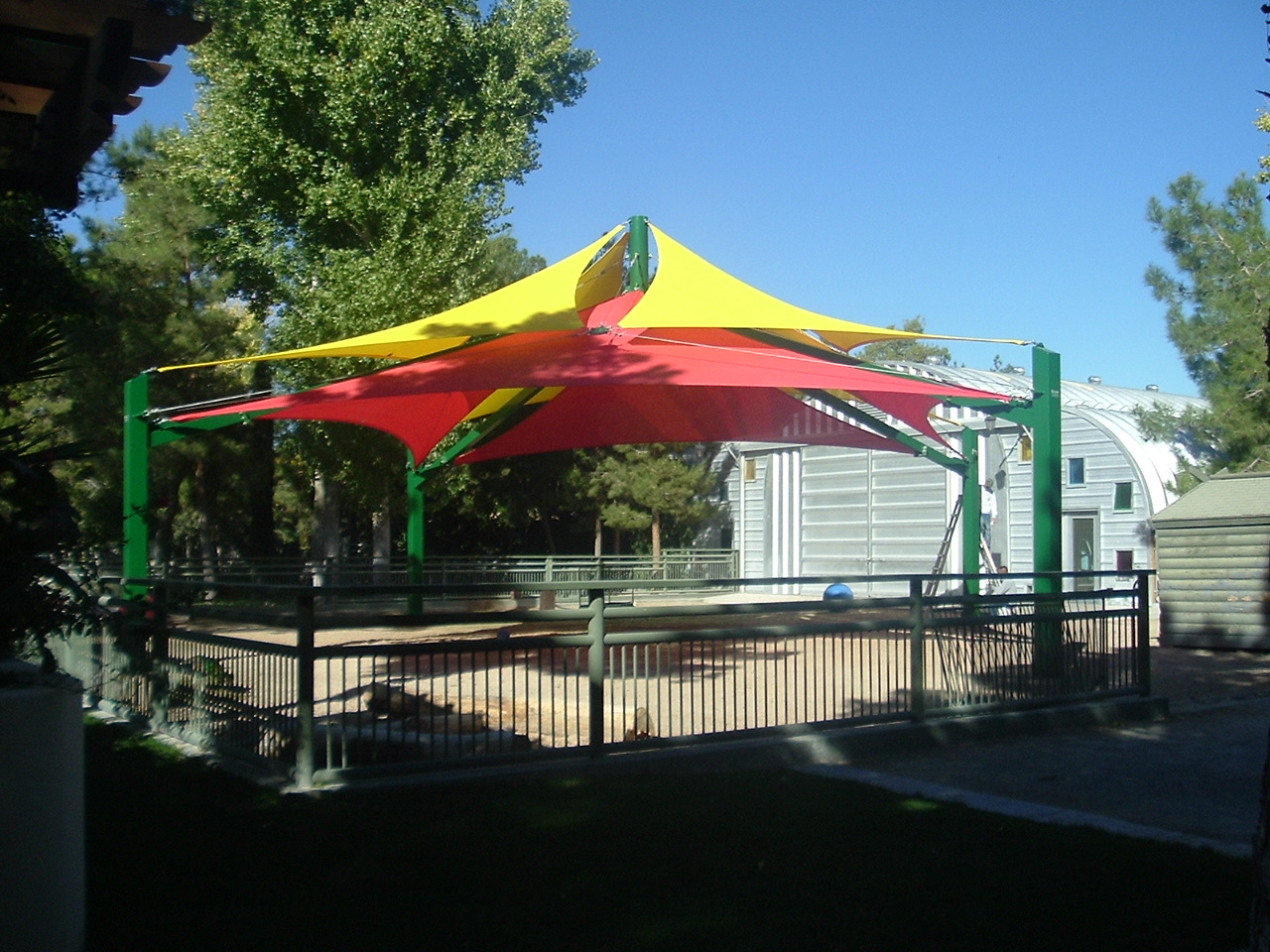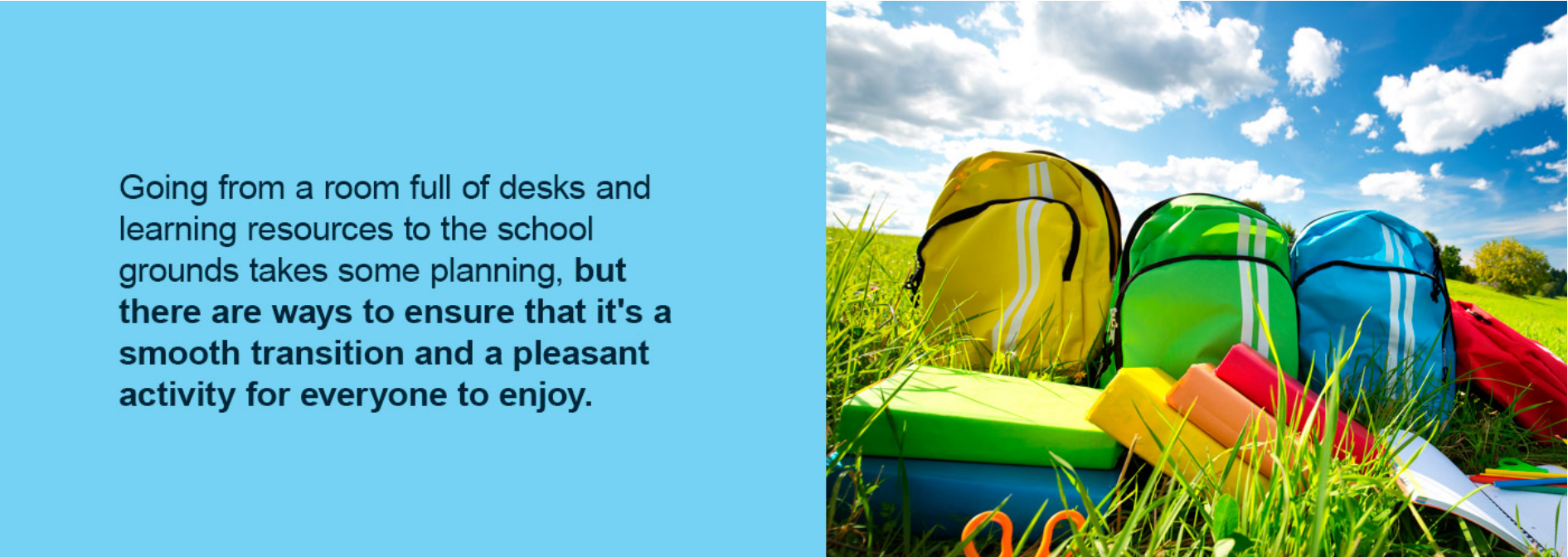It’s hard to stay cooped up in the classroom when it’s nice outside. Children and teachers alike may catch themselves longing to be out in sunshine and fresh air during the school day. So instead of fighting to keep students’ attention, why not reap the benefits of outdoor learning? Moving class into the open air is loaded with educational benefits and can be a great way to shake things up. Plus, with new pandemic protocols, outdoor education can be a safe alternative for social distancing and mask breaks.
Taking students outside can require some forethought and planning, and we want to help you make the most of your time. Here are the reasons to invest the energy in outdoor learning, the ways you can set up an ideal outdoor environment and ideas for curriculum-friendly activities!
Read the full article or jump to a specific section:
- Benefits of Outdoor Learning for Students
- How to Set Up Your Outdoor Learning Space for Activities
- Activity Ideas for Outdoor Education
- Shade Structures for Education Facilities
- Partner with USA Shade on an Outdoor Classroom
Benefits of Outdoor Learning for Students
Some educators may see outdoor learning as a recipe for distraction and chaos, but the research shows otherwise. Improved attention, school performance and well-being are all benefits of outdoor learning for students, not to mention the opportunities for some mask breaks that are made possible due to the open air and space for social distancing.
Attention
Changing things up, or fostering novelty, is actually a great way to recapture student focus and attention. Research indicates that novelty is a way to boost learning. “Brain imaging has shown that there are specific areas in our brain designed to recognize novelty,” writes Charles Laurent in EducationWeek. “When a child notices that something has changed or something is new, areas of the brain are triggered and the result is a reexamination of static concepts or ideas.” Incorporating novelty can be as simple as swapping desk arrangements, but the effect can wear off. Going outside presents far more opportunities to change things up for your students!
School Performance


Research also points to the fact that students perform better in all areas when they’re taught outdoors. One report compiled by the National Wildlife Federation demonstrates that students who participated in outdoor education improved their standardized test scores as well as performed better in math, reading, science and social studies. Learning outside and in nature also improved their in-school behavior, attendance and attitudes toward school.
Physical, Mental and Social Health
Outdoor education also improves students’ physical, mental and social health. It’s no secret that physical activity enhances learning and retention in children and boosts their mental well-being. Outdoor learning also improves their problem-solving and relational skills, fostering independence, self-awareness, creativity, empathy, motor skills, self-discipline and initiative. Catering to the well-being of the whole child, as opposed to just their academic performance, is an important aspect of education that sometimes gets pushed to the wayside, but outdoor learning can turn that around!
Counterbalance Technology
Technology is a fact of life, and it’s important for students to learn to use it in order to be successful. In some schools, Chromebooks or other devices are incorporated into the classroom and are now a fact of life. Still, the negative effects of technology on children cannot be overstated. Some of the major issues, such as diminished attention span, obesity and stunted social development, are actually counterbalanced by outdoor learning. Outdoor education improves attention, is more physically engaging than the classroom and teaches students important social skills. Even using laptops in the shade could give kids a boost of vitamin D and fresh air, or even a mask break if pandemic protocols are in place.
Relief from Pandemic Protocols
The realities of the pandemic have forced local officials and school districts to implement mitigation measures against the virus. Whether it’s masks, plastic partitions, social distancing or online learning, many teachers have been forced to adapt and adapt quickly. Fortunately, most protocols and official recommendations say that gathering outdoors is safer than indoors and even safe enough to go maskless if social distancing requirements are met. Taking students out for learning time that’s mask-free can be a relief for teachers and students alike, while still keeping with important health precautions.
How to Set Up Your Outdoor Learning Space for Activities
Shifting from the classroom to the outdoors may seem like an overwhelming task. Going from a room full of desks and learning resources to the school grounds takes some planning, but there are ways to ensure that it’s a smooth transition and a pleasant activity for everyone to enjoy. Depending on the school, there may already be pre-established places that can accommodate students and learning activities; even so, here are some things to consider when relocating outside:
- Preparation: Be sure students are properly attired for your outdoor learning activities and that the location you plan to use is not being used by other teachers.
- Proximity to restrooms: Ensure that the location you choose is within a reasonable proximity to a restroom. Also consider the supervision implications of sending children to the restroom unattended.
- Access to water: If there isn’t a nearby, accessible water fountain, make sure students bring water bottles or are given a water break when brought inside.
- Seating: Adequate seating can keep outdoor learning organized if students need to work on assignments. If you choose to sit on grass or concrete, plan ahead for something students can sit on. No one wants a sore or wet bottom!
- Shade: Protecting children from sun exposure and UV rays is important. Not only can it extend the time you spend outside, it may be necessary for the safety and comfort of the students.
If your school is lacking any of these options outside, consider talking to the school board and principal about funding for putting seating and shade structures in place for future classes and students.
Activity Ideas for Outdoor Education
Shifting to an outdoor environment isn’t the only intimidating thing about outdoor learning. Lesson planning can be daunting as well. Creating engaging activities that students enjoy takes effort, creativity and planning. To make it easier, we’ve compiled some ideas to jumpstart your imagination to help you plan for a fun-filled lessons and activities that also have equally great academic merit.
Science
Science is a fascinating and expansive subject that is important to understanding the natural world. Nature is the perfect place to inspire future naturalists and scientists, transforming learning about science into actually doing it for themselves! Earth science is an obvious choice for outdoor education, but messy chemistry experiments or engineering projects can also benefit from going outside. Here are some ideas for outdoor learning science activities:
- Scavenger hunts — Ask students to collect leaves, rocks, twigs, seeds, feathers and other natural items that can be traced, drawn or discussed.
- Nature journaling and observations — Invite students to explore the natural environment around the school and practice writing down their scientific observations of the weather, ecosystem, animals or insects. Live sketching their discoveries can be a fun addition to written observations.
- STEM projects — STEM projects are an exciting way to increase interest in technical subjects, and they can be uniquely suited for outdoor learning! Try building mini solar panels, stick forts, sundials, water clocks or even a catapult to spark imaginations and engage in fun learning time!
- Chemistry experiments — The classic experiment of putting mentos into a liter of Coke is not possible in the classroom. Students love reactionary or messy experiments and with outdoor learning, teachers can give it to them — without destroying the carpet.
Science may be one of the easiest subjects to incorporate outdoor learning lessons. Give your students hands-on learning experiences that they’ll remember for years to come.
Math
Taking math outside may not seem very intuitive, beyond doing assignments on outdoor tables, but here are some other ways to make math more tactile and engaging:
- Chalk equations — Use sidewalk chalk to solve equations or draw grids.
- Practice math problems — Teach counting, addition and subtraction using outdoor objects.
- Real-world geometry — Try geometry equations with natural angles around the school or using the school building itself.
- Learn measurements and fractions — Bring rulers and measuring tapes outside to measure trees, tables, benches and other outdoor items.
- Math games — Turn physical games into math problems, such as addition olympics or relay races that require solving mental math problems.
Students often complain about real-life lesson application. What better way to demonstrate its relevance than making equations, numbers, data and calculations more tangible?


ELA and Reading
Language arts and reading can also utilize outdoor learning to engage students’ minds. Try these ideas out for your next reading or English class:
- Journaling — Bring students outside and allow them to choose a quiet spot for personal reflection and contemplation. Then instruct them to journal their thoughts and feelings.
- Read-aloud groups or SSR — Assign reading groups to spread out around outdoor spaces to read in groups. This also works well for silent reading time!
- Poetry — Nature is an important theme in poetry. Ask students to take in the natural spaces around the school and write poems inspired by them. This could be especially helpful for haikus, which are traditionally based on nature.
- Spelling — Use sidewalk chalk to practice spelling, handwriting or letters.
- Act it out — Form groups of students to act out scenes from assigned reading books or even Shakespeare.
There are other great kinesthetic ELA games to try, such as tossing a ball from student to student to spell words or express ideas. Teaching critical thinking and reading skills outside is a great way to engage students in new ways!
Additional Subjects
Science, math and language arts aren’t the only subjects that can be explored outside. Here are some ideas for other classes as well:
- Social Studies and history — Building a catapult may be a STEM project, but it could also be used to teach about the Roman Empire! Repurpose the ELA and reading activities to reenact historical events, memorize geography, persons and dates or read historical documents. You can also bring history to life by going to museums or historical sites, especially if they’re local!
- Art — Nature and art are another subject that go hand-in-hand. Paint en plein air, create tie-dye shirts or sketch natural settings. Try out messy projects you’re too scared to do in the classroom!
- Study hall — Going outside for homework time or study hall is a good way to shake things up and give your students a break from monotony. It can also be used as a reward for good behavior in the classroom!
This is by no means an exhaustive list of activities or subjects that can be experienced during outdoor learning.
Shade Structures for Education Facilities
Installing adequate shade at an education facility can open new possibilities for educators to serve their students. Relying on buildings and trees may work some of the time but is limited by the time of day, weather, size and season. Shade structures, on the other hand, are outfitted to expand outdoor learning opportunities by offering the following:
- Proper angling to ensure longer daytime protection from sun exposure and UV rays
- Temperature regulation in shaded areas, as well as a place that captures the breeze
- Ample room for social distancing
- Technology integration such as lighting, video and audio into the actual structure
- Reduced sun glare on laptops and other devices
- A selling point to use during open-school nights and recruitment
With all the benefits of outdoor learning, there’s never been a better time to not just adapt to new normals but to exceed them.

Partner with USA Shade on an Outdoor Classroom
Incorporating outdoor education is good for students’ academic success, as well as their physical, social and mental well-being. Educators across the globe are embracing this new trend and encouraging their peers to do the same. But if a school’s only option is a sun-soaked field, sports bleachers, gravely ground or concrete, it can be hard to get on board with the movement. Installing a commercial shade structure or shade sail to create an outdoor classroom can make all the difference, and USA Shade and Fabric Structures is the perfect partner to make it happen!
At USA Shade, we work with schools to design and install 3-Point, 4-Point Hyper and 5-Point Sail structures that produce the right amount of shade with an appealing look. We can vary column heights to address the varying angles of sun exposure throughout the day and even style the sails according to your school colors. We can even feature logos and mascots for an even more customized look! Our experts are available to assist you in every step of the process, from the preliminary planning phases all the way through installation. They’ll look at your school grounds and customize a plan for your school’s specific needs with thoughtful guidance and unparalleled care. Current COVID grants and education funding present the perfect opportunity to invest in a shade structure now.
We want to help you invest in your students by supporting their outdoor education. To start a conversation about your school’s needs, fill out this form or browse our brochures to see the possibilities that await you.







